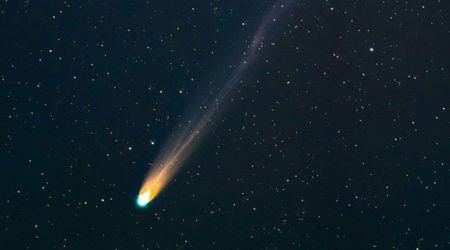'Extremely rare' celestial event captures two naked-eye novae appearing at the same time

The Southern Hemisphere is currently experiencing an exceptionally rare celestial phenomenon: the simultaneous appearance of two naked-eye novae. This unusual event follows the dramatic brightening of V462 Lupi in the constellation Lupus, confirmed on June 12, and the more recent discovery of V572 Velorum in Vela on June 25, according to EarthSky.

V462 Lupi, initially detected by the All-Sky Automated Survey for Supernovae (ASAS-SN) at an apparent magnitude of 8.7, rapidly escalated to naked-eye visibility. Spectroscopic analysis by Yusuke Tampo of the South African Astronomical Observatory (University of Cape Town) swiftly confirmed its classification as a classical nova. It currently maintains a magnitude of approximately +5.9.

Just over a week later, observers John Seach and Andrew Pearce identified V572 Velorum in the constellation Vela. Upon discovery, this "new star" shone at magnitude +5.7, a brightness within the range for unaided observation. Recent reports indicate it has since brightened further to magnitude +5.5. While individual novae are common, the concurrent visibility of two such events presents a unique opportunity for astronomers and enthusiasts alike. Southern Hemisphere residents in dark-sky locations may be able to glimpse both V462 Lupi and V572 Velorum, offering an unprecedented view of these stellar outbursts, per EarthSky.

The simultaneous appearance of V462 Lupi and V572 Velorum is being hailed as an "extremely rare, if not a historical one," according to astronomer Stephen O’Meara, who has been extensively researching historical records, stated, "I have yet to find an occurrence of two simultaneous nova appearing at the same time." He recounted a previous instance in 1936 involving V630 Sgr and V368 Aql, but noted that their peak brightness did not align, as mentioned on Spaceweather.com.
O’Meara further noted a more recent, albeit brief, dual nova event in the AAVSO archives. "On March 22, 2018, Nova Circinis 2018 reached a peak brightness of magnitude 5.8, and on that same day, Nova V906 Carinae peaked at around magnitude 5.9. So these two novae shared a similar naked-eye magnitude, albeit briefly. So these are rare events." This demonstrates the exceptional rarity of such concurrent naked-eye novae.

These events are classified as classical novae, a phenomenon first documented by Chinese astronomers approximately 2000 years ago. These stellar explosions occur in binary star systems where a dense white dwarf star siphons off gas from a companion star. This stolen fuel eventually ignites in a sudden thermonuclear blast, creating a spectacular, albeit less powerful, explosion than a supernova. The threshold for naked-eye visibility is typically a magnitude of 6.0, and both V462 Lupi and V572 Velorum are currently brighter than this. Eliot Herman has already captured an image of V572 Velorum using a robotic telescope in Chile on June 28.
While all novae involve eruptions on a star's surface, these celestial events exhibit distinct characteristics, primarily categorized into two main types: classical and recurrent. The duration and intensity of a nova, as well as the type of companion star involved, contribute to this diversity. Classical novae, such as the recently observed V462 Lupi, are characterized by a single recorded outburst within a human lifespan. Though these systems are expected to erupt again, the time required for sufficient material to accrete onto the white dwarf's surface can span thousands to millions of years, making subsequent events incredibly rare from an observational standpoint, according to NASA.

In contrast, recurrent novae live up to their name by experiencing multiple recorded outbursts. The exact mechanisms driving this more frequent eruption cycle are still under scientific investigation. However, researchers theorize that factors such as the nature of the companion star and the rate at which the white dwarf accumulates stellar material play significant roles in determining a nova's recurrence.









